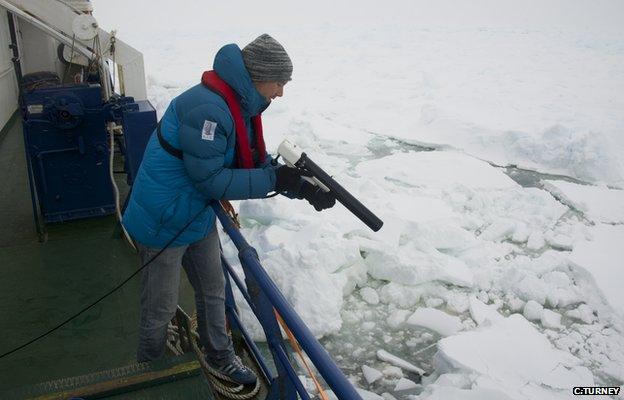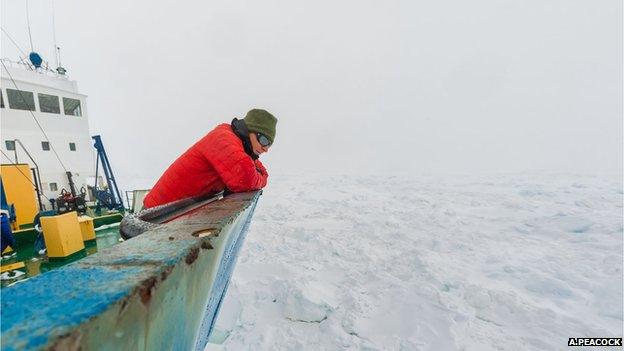Science continues for trapped Australasian Antarctic expedition
- Published

Erik van Sebille aims for cracks in the sea ice to carry out his ocean research
Science reporter Andrew Luck-Baker is on board the Russian research vessel Shokalskiy, covering the Australasian Antarctic Expedition 2013, external for the BBC World Service programme Discovery. He recounts how the expedition spent Christmas Day trapped in sea ice.
Scientists currently stuck in dense pack ice off East Antarctica are making the most of their expected four days locked in the frozen sea.
The research programme of the Australasian Antarctic Expedition (AAE) 2013 is continuing from the deck of the beset Academik Shokalskiy - although not quite as originally intended.
The science team, led by Chris Turney and Chris Fogwill, both geologists from the University of New South Wales, has decided to use the trapped vessel as a static platform for investigations beneath the pack.
On 24 December, the AAE's ice-strengthened vessel was just departing the Commonwealth Bay area in remote East Antarctica when fierce winds began tearing off the polar plateau.
The blizzard set in motion an armada of rafts of pack ice and the Shokalskiy became surrounded and trapped.
Barely a pool of water now shows in the chaotic icescape of floes and piles of shattered, brilliant white blocks. This vista extends as far as we can see in almost all directions.
Tantalisingly, a low band of grey sky to the Northeast suggests clear water lies not so many kilometres away. The grey colour is light reflected from open water. The early Antarctic explorers named this colour phenomenon "water sky" and used it to navigate their route through the treacherous pack ice.
Douglas Mawson also used this lore of the polar seas to guide his expedition in these same waters, more than a century ago. Mawson led the original Australasian Antarctic Expedition which discovered and explored this region of the White Continent for more than two years.
The first AAE studied or measured every aspect of the natural environment in and around Commonwealth Bay - such as the ice, the weather, the geology, and the animals, from penguins to leopard seals (the local top predator).

Chris Fogwill is retracing the steps of Douglas Mawson a century ago
The goal of the modern day Australasian Antarctic Expedition is to repeat many of the original measurements and studies, to see how facets of the environment have changed over the past century. This passage of time coincides with warming and climate change in Antarctica.
During the morning on Christmas Day (New Zealand time), the Russian Captain Igor Kiselev decided to send out a distress call to the Marine Rescue Coordination Centre. The pack ice was (and remains) thick; and at the time of his decision, there were two large icebergs moving in parallel to the trapped vessel on the prevailing east to west current. Those bergs were not on collision course and they have since stopped moving any closer.
According to Prof Turney: "The situation has stabilised and all on board are well. We are now trying to make the best scientific use of our time while waiting for the arrival of an icebreaker to release us in the next 24 hours. For anyone concerned at home, please check 'The Spirit of Mawson', external website for regular updates."
In addition to the Russian crew of 22, the expedition team consists of 18 professional scientists from Australia and New Zealand, and 22 volunteer science assistants. They are members of the public, ranging in age from their 20s to their 70s. They paid to join the scientific adventure.
For scientists and punters alike, it was a Christmas Day like no other. There was some anxiety early on Christmas Day when our predicament was explained at a morning briefing by the expedition co-leaders, which in addition to Turney and Fogwill counts the veteran polar explorer Greg Mortimer.
But the otherworldly white vista from the decks and the realisation that we were not in acute peril created a communal excitement and realisation that we were going to have a most unique Christmas.
"It's fantastic - I love it when the ice wins and we don't," said expedition marine ecologist Tracy Rogers. "It reminds you that as humans, we don't control everything and that the natural world - it's the winner here. We've got several penguins watching us, thinking 'what the hell are you doing stuck in our ice?'. The sky is a beautiful grey - it looks like it wants to have a bit of a snow. It's the perfect Christmas, really."
The passengers and crew onboard the trapped Akademik Shokalskiy sing Auld Lang Syne to bring in the New Year
Science volunteer Sean Borkovic also seemed to be enjoying the experience: "I'll always remember this, that's for sure. It's brilliant. We've got some lovely light and the weather's pretty mild considering. The ship looks solid. I think we'll be good."
A visit from Secret Santa and a sumptuous Christmas dinner cranked up the celebratory mood.
In response to the distress call, a large Chinese icebreaker is now on its way to free the Shokalskiy. The Xue Long (Snow Dragon) is expected to reach us at about 1300 GMT on 27 December. It is massive enough to cut a path through the ice so the Australasian Antarctic Expedition can make a break for the open waters not so very far away.
In the days before the AAE 2013 became trapped, the scientists made several significant discoveries. For instance, the expedition's ornithologist, Kerry-Jayne Wilson, discovered that the colony of Adelie penguins in Commonwealth Bay, close to Mawson's old base, now contains the smallest number of breeding pairs ever recorded there.
Findings by the AAE's oceanographer Erik van Sebille, of the University of New South Wales, are also significant. He discovered that the water beneath the extensive sea ice covering Commonwealth Bay at this time of year is much fresher, less salty than in Mawson's times.
This finding is of global interest. Commonwealth Bay is one of the metaphorical cylinders of the great heat engine of the global ocean system.
The winds and cold temperatures here normally generate great volumes of very cold and very salty water. This dense water plunges to abyssal ocean depths and helps to drive the circulation of water from pole to equator, redistributing heat around the planet.
Van Sebille's discovery of such freshwater at depths of 50m suggests the oceanic engine here has stalled. The planetary consequences of that are as yet unclear.
A crew member on the Russian ship which has been stranded off East Antarctica for almost a week has recoded a video diary
Although trapped for the moment, Erik van Sebille and others plan to continue their studies from the Shokalskiy. He is currently deploying instruments to measure temperature and salinity through cracks in the surrounding ice. His findings may add to the picture of freshening water which he first saw a few days ago further to the west.
Prof Rogers also plans to continue her studies of the local leopard seals.
She will be lowering a loudspeaker into the chilly waters and then playing the submarine song of a male leopard seal that she recorded elsewhere in Antarctica. With an underwater microphone, Rogers will then record the response to the singing of this apparent interloper by the resident leopard seals.
Her theory is that male leopard seals sing to define the boundaries of their territory. She's expecting to hear the locals singing louder and closer in reaction to the false stranger she's planting through the pack ice.
The fact that the Shokalskiy's engines will be quiet for at least another day is of some advantage to her experiments.

The Shokalskiy is protected against the ice but will need a Chinese ice-breaker to clear a path to freedom
Listen now to Discovery on the BBC World Service and The Return to Mawson's Antarctica, Part One, presented by Alok Jha.
- Published13 December 2013
- Published11 December 2013
- Published9 December 2013